
An optical colour image of galaxies is seen here overlaid with X-ray data (magenta) from NASA's NuSTAR. Photo: NASA/JPL-Caltech
WASHINGTON (PTI): In a major milestone, NASA's new black-hole-hunter spacecraft - NuSTAR - has detected its first 10 supermassive black holes, lying at the hearts of distant galaxies between 0.3 and 11.4 billion light-years from Earth.
The mission, which has a mast the length of a school bus, is the first telescope capable of focusing the highest-energy X-ray light into detailed pictures, researchers said.
The new black-hole finds are the first of hundreds expected from the mission over the next two years.
These gargantuan structures - black holes surrounded by thick disks of gas - lie at the hearts of distant galaxies between 0.3 and 11.4 billion light-years from Earth.
"We found the black holes serendipitously," said David Alexander, a NuSTAR team member based in the Department of Physics at Durham University in England and lead author of the study.
"We were looking at known targets and spotted the black holes in the background of the images," said Alexander.
Additional serendipitous finds such as these are expected for the mission, researchers said.
Along with the mission's more targeted surveys of selected patches of sky, the the Nuclear Spectroscopic Telescope Array, or NuSTAR team plans to comb through hundreds of images taken by the telescope with the goal of finding black holes caught in the background.
The scientists found that the objects had been detected before. It wasn't until the NuSTAR observations, however, that they stood out as exceptional, warranting closer inspection.
By combining observations taken across the range of the X-ray spectrum, the astronomers hope to crack unsolved mysteries of black holes. For example, how many of them populate the universe?
"We are getting closer to solving a mystery that began in 1962," said Alexander.
"Back then, astronomers had noted a diffuse X-ray glow in the background of our sky but were unsure of its origin. Now, we know that distant supermassive black holes are sources of this light, but we need NuSTAR to help further detect and understand the black hole populations," Alexander said.
This X-ray glow, called the cosmic X-ray background, peaks at the high-energy frequencies that NuSTAR is designed to see, so the mission is key to identifying what's producing the light. NuSTAR can also find the most hidden supermassive black holes, buried by thick walls of gas.
"The highest-energy X-rays can pass right through even significant amounts of dust and gas surrounding the active supermassive black holes," said Fiona Harrison, a study co-author and the mission's principal investigator at the California Institute of Technology, Pasadena.
The study was published in The Astrophysical Journal.
 Previous Article
Previous Article Next Article
Next Article













The Indian Air Force, in its flight trials evaluation report submitted before the Defence Ministry l..
view articleAn insight into the Medium Multi-Role Combat Aircraft competition...
view articleSky enthusiasts can now spot the International Space Station (ISS) commanded by Indian-American astr..
view article